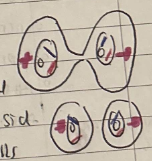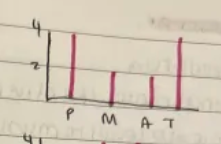2.4 MITOSIS
1/29
There's no tags or description
Looks like no tags are added yet.
Name | Mastery | Learn | Test | Matching | Spaced |
|---|
No study sessions yet.
30 Terms
WHAT ARE THE THREE STAGES OF THE CELL CYCLE?
Interphase: G1, 2, G2.
Nuclear Division: Mitosis/Meisos.
Cytokinesis: Cell movement; cell division.
DNA CHROMOSOMES BEFORE AND AFTER INTERPHASE:
DNA: 2 then 4.
CHROMOSOME: 2 and then still 2.
WHAT OCCURS IN G1?
Growth.
Organelles duplicate.
Increased respiration and {protein}.
WHAT OCCURS IN S?
{DNA} - DNA replicated so that each chromosome is double-stranded.
Energy (ATP) is saved up for cell division.
WHAT OCCURS IN G2?
Growth and preparation for mitosis.
Check for cell mutations.
Increased respiration and {protein}.
WHAT OCCURS IN MITOSIS?
Number of cells during growth.
Replaces tissue during repair.
Allows asexual reproduction; produces two genetically identical daughter cells.
WHAT HAPPENS IN MITOSIS?
Asexual reproduction. A parent cell divides to produce two genetically identical daughter cells.
Increases the number of cells during growth.
Replaces tissue during repair.
WHEN CAN IDENTICAL DAUGHTER CELLS BE IDEAL?
When organisms are rapidly establishing a population and variation would be a disadvantage.
WHAT IS THE ONLY WAY VARIATION COULD OCCUR IN MITOSIS?
Random mutation.
WHAT ARE THE FOUR STAGES OF MITOSIS?
PMAT (Please make another two / Police make another take).
Prophase.
Anaphase.
Metaphase.
Telophase.
PROPHASE?
Chromatin condenses and becomes inactive.
Centrioles migrate in pairs to opposite poles.
Nuclear envelope and nucleolus break up.
Chromosomes tightly coiled and visible.
Mitotic spindle forms at centrioles.

METAPHASE?
Mitotic spindle grows further and attaches to the centromere of each chromosome.
Fibres then arrange the chromosomes to line up along the equator.

ANOPAHSE?
Centromere of each chromosome breaks.
Sister chromatids separate into daughter chromosomes.
Cell begins to elongate as cytokinesis begins.

TELOPHASE?
New nuclear membranes and nucleoli form.
Chromosomes unwind back into chromatids and are no longer visible.

CYTOKINESIS?
Cytoplasm splits to create two daughter cells.
Membrane forms in the middle of the cell.
Eventually, cell membranes form and two daughter cells separate.

DIVISION IN MULTICELLULAR ORGANISMS?
In multicellular organisms, not all cells contain the ability to divide, e.g. neurons.
HOW MANY UNITS OF DNA ARE PRESENT AT EACH STAGE OF MITOSIS?

HOW MANY UNITS OF DNA ARE PRESENT AT EACH STAGE OF INTERPHASE?

MITOTIC INDEX?

HOW DO PROKARYOTIC CELLS DIVIDE?
BINARY FISSION:
Replication of the circular DNA, including plasmids.
The cell membrane begins to grow between the two main DNA loops and begins to pinch inwards, dividing the cytoplasm in two.
The new cell wall forms between two DNA loops, forming two daughter cells, each with a copy of the main DNA loop and a variable number of plasmid (copies).
HOW DO VIRUSES REPLICATE?
Non-Living :: No cell division.
Instead they (this is all one process not options):
Replicate by attaching to a host cell by using attachment proteins on their surface.
They inject their nucleic acid into the host cell.
Host cell used to produce viral components (i.e. proteins).
Components assembled into new viruses.
WHAT ARE THE FOUR STAGES OF CANCER?
Uncontrolled cell division.
Mutations in genes that control cell division.
Rapid, uncontrolled growth that leads to a mass of abnormal cells - tumour.
Metasis (spreads).
WHICH GENES CONTROL CELL DIVISION?
Protooncogenes (accelerant).
Tumur supressor genes (brake).
DNA repair enzyme genes.
(They all produce a corresponding gene which does the actual job, and the protein can only act once.)
HOW DO CANCER CELLS DIFFER TO NORMAL CELLS?
Spend longer in mitosis than interphase.
Don’t respond to signals from nerves and hormones as healthy cells and don’t undergo apoptosis (programmed cell death) - which would normally occur when irreparable damage is detected.
HOW MAY CANCER DEVELOP?
If a cell’s DNA is faulty/damaged, p53 (protein) normally stops the cell cycle - to prevent the faulty cell from dividing and forming faulty daughter cells.
Mutations of the gene coding for the protein can cause cancer to develop in the following way:
p53 genecodes for production of p53 protien.
Mutation fo p53 gene means no p52 proteins are made/protein is non-functional.
Cell with damaged DNA completes cell cycle and divides.
Uncontrolled cell division produces cancer.
WHAT ARE THE CAUSES OF CANCER?
Inherit mutations in gene suppressors.
Environment (disturbs DNA replication).
WHAT ARE MALIGNANT AND BENIGN TUMURS?
Malignant:
Harmful because of where they grow.
Not contained in a membrane.
Not slow growing.
Not compact.
Benign:
Opposite.
HOW CAN CANCER BE TREATED?
Part of the cell cycle must be blocked therefore the rate of cell division can be controlled. This can be done through two methods:
DRUGS:
Prevent DNA deplication.
Prevent spindle formation (:: prevents metaphase).
Prevent DNA winding.
CHEMO:
Prevent DNA replication.
Prevent spindle formation (:: prevents metaphase).
X Because they stop metaphase in ANY fast growing cell e.g. hair and lining of the gut.
WHERE ARE THE CHROMSOMES CONTAINED?
HOW MANY DO HUMANS HAVE?
Nucleus of all eukaryotic cells contains a set number of chromosomes.
23 homologous pairs (m & f).
WHAT HAPPENS TO CHROMSOMES BEFORE CELL DIVISION?
DNA in chromosomes replicates all the way along its length.
Each chromosome becomes a chromatid (two threads) that are held together at the centromere.
As cell division begins, the chromosomes shorten and condense (thicken) because the DNA coils more tightly around the histone protein.